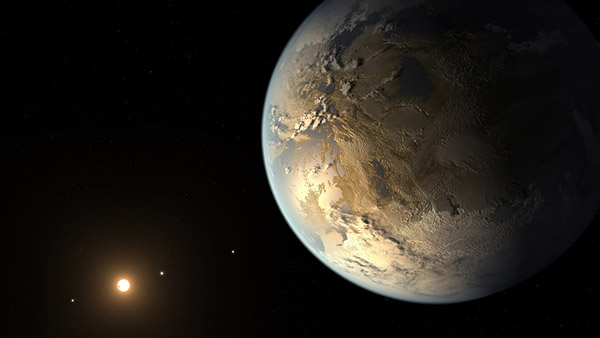Scientists Discover A New Earth-Like World. This Is The First Validated Habitable Planet
April 18, 2014

NASA Ames/SETI Institute/JPL-CalTech
It is a bit bigger and somewhat colder, but a planet circling a star 500 light-years away is otherwise the closest match of our home world discovered so far, astronomers announced on Thursday.
The planet, known as Kepler 186f, named after NASA's Kepler planet-finding mission, which detected it, has a diameter of 8,700 miles, 10 percent wider than Earth, and its orbit lies within the "Goldilocks zone" of its star, Kepler 186 — not too hot, not too cold, where temperatures could allow for liquid water to flow at the surface, making it potentially hospitable for life.
"Kepler 186f is the first validated, Earth-size planet in the habitable zone of another star," Elisa V. Quintana of the SETI Institute and NASA's Ames Research Center in Mountain View, Calif., said at a news conference on Thursday. "It has the right size and is at the right distance to have properties similar to our home planet."
Dr. Quintana is the lead author of a scientific paper describing the findings in this week's issue of the journal Science. Kepler 186f is the latest planet to be sifted out of the voluminous data collected by Kepler, which kept watch over 150,000 stars, looking for slight drops in brightness when a planet passed in front.
The researchers speculate that it is made of the same stuff as Earth — iron, rock, ice, liquid water, although the relative amounts could be very different.
The gravity on Kepler 186f, too, is likely to be roughly the same as Earth's. "You could far more easily imagine someone being able to go there and walk around on the surface," Stephen Kane, an astronomer at San Francisco State University and another member of the research team, said in an interview.
"It's fun to note that if the planet is habitable, photosynthesis may be possible," said Victoria Meadows, an astrobiologist and planetary astronomer at the University of Washington.
At the wavelengths that plants need, Kepler 186f receives only about a sixth as much light as Earth does, but "there are plenty of Earth plants that would be quite happy with that," Dr. Meadows said.
Click Here For The Most Popular On Sunny Skyz
 Boy With Down Syndrome Nails The Whitney Houston Challenge, And The Crowd Goes Wild
Boy With Down Syndrome Nails The Whitney Houston Challenge, And The Crowd Goes Wild
 The Funniest Wildlife Photos Of 2025 Are Here ŌĆö And TheyŌĆÖre Hilarious
The Funniest Wildlife Photos Of 2025 Are Here ŌĆö And TheyŌĆÖre Hilarious
 This 30-Year-OldŌĆÖs Christmas Gift To His Mom Is Going Viral
This 30-Year-OldŌĆÖs Christmas Gift To His Mom Is Going Viral
 Police 'Arrest' A Lost Cat For 'Assault' ŌĆö And She Has No Regrets
Police 'Arrest' A Lost Cat For 'Assault' ŌĆö And She Has No Regrets
 A Couple Invited A Homeless Man In On Christmas ŌĆö And He Never Left
A Couple Invited A Homeless Man In On Christmas ŌĆö And He Never Left
 Police OfficerŌĆÖs Simple Question Leads To An Unforgettable Christmas Moment
Police OfficerŌĆÖs Simple Question Leads To An Unforgettable Christmas Moment
 He Asked For Help Wrapping A Christmas Present ŌĆö Then Surprised Her With A Life-Changing Gift
He Asked For Help Wrapping A Christmas Present ŌĆö Then Surprised Her With A Life-Changing Gift
 The Hug That Went Viral On Facebook
The Hug That Went Viral On Facebook
 You Have To See This 'Piggy Train' Trotting Through The Snow
You Have To See This 'Piggy Train' Trotting Through The Snow
 SheŌĆÖs Been Helping Hungry Children For Years ŌĆö This Christmas, Someone Helped Her
SheŌĆÖs Been Helping Hungry Children For Years ŌĆö This Christmas, Someone Helped Her
 This Teacher Found A Simple Way To Make Every Student Feel Loved
This Teacher Found A Simple Way To Make Every Student Feel Loved
